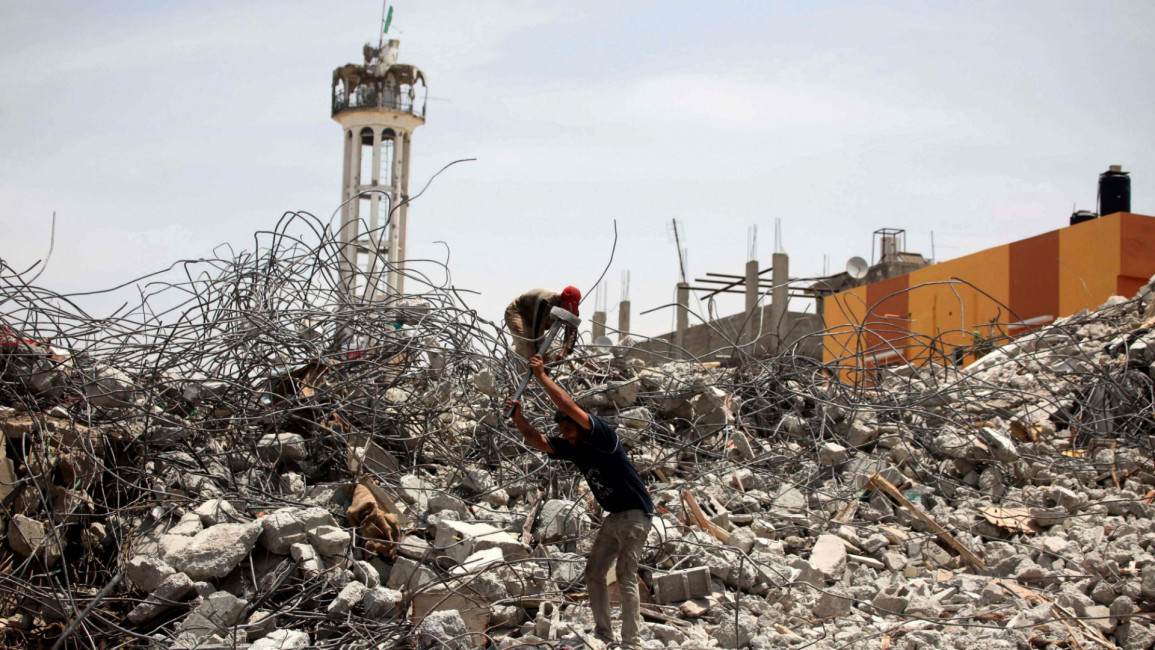
A year after Protective Edge, Gaza is still hurting
It's been nearly a year since Ismail Abu Aitah, 24, was shaken from his bed by a "huge boom" that shook his street in Jabalya in northern Gaza. Abu Aitah woke his other family members to get them to the ground floor, where he thought they would be safe.
The next thing he remembers is waking up in al-Shifa Hospital. His head, chest and feet were injured. He needed more than 60 stitches. He would soon hear the worst of the news: His neighbour's house had been levelled, his own house was barely standing and he had lost five of his family members - his mother, father, two brothers and a four-year old nephew.
| More than 160,000 houses in Gaza were destroyed or damaged in last year's Israeli attack. |
"I blamed myself for what happened," says Abu Aitah, who is documenting his story for a new project called We Are Not Numbers."I couldn't stop thinking that if it wasn't for me waking them up, and getting them to run downstairs, things would be different. I was so angry that I wasn't the one who died in their stead."
Death and destruction
Abu Aitah's story is tragic, but not unique. His family members were among more than 2,000 Palestinians - mostly noncombatants - who were killed in last summer's 50-day assault Israel dubbed "Operation Protective Edge".
According to the Palestinian Ministry of Health, 145 families lost three or more members in a single strike, as Abu Aitah's did. He also was one of nearly 11,000 who were wounded. An estimated third of them will suffer lifelong disabilities. Fortunately, Ismail is not one of them.
Today, he is responsible for three younger sisters, seven nephews and a newborn niece, although an older sister who had been attending university in the US will return home this summer.
Like most other families who lived in one of the more than 160,000 houses destroyed or damaged, his home is far from rebuilt - despite the promises of aid at October's reconstruction conference in Cairo.
Although $5.4 billion was widely publicised as the total pledged at the conference, only $3.5 billion of it was actually allocated to Gaza. As of late April, IRIN news service reported, donors had given only 27.5 per cent of the promised funds, or $967 million.
If a "list of shame" was created, Qatar, Saudi Arabia, Turkey and Kuwait would be at the top, making good on just 10 percent or less of their promises. The European Union's stands at 40 per cent, and the US comes in at a comparatively good 84 per cent.
However, the total amount pledged and relative wealth must be taken into account as well. The US, for example, promised $348 million compared to $1 billion each by Qatar and Saudi Arabia, despite the fact that America played a significant role in funding and arming the army that inflicted the disproportionate damage.
In addition to the lack of funding, which caused the UN Relief and Works Agency (UNRWA) to suspend its cash assistance program for repairs and rent in January, Israeli restrictions are also responsible for the fact that so few construction materials have entered Gaza.
The Israeli organisation Gisha reports that of the five million tonnes of construction materials needed, only nine percent has actually entered Gaza. The result, says UNRWA is that not a single destroyed home has been rebuilt to date.
UNRWA claims repairs have been completed on approximately 60,000 houses, nut Abu Aitah's is not among them. His remaining family has not received any financial assistance for rebuilding, which he estimates will cost him as much as $8,000, forcing him to spend the $2,000 he was given as partial compensation for his injuries by a donor government.
No future
| Promises to loosen the blockade have not been kept. |
Although a recent graduate of Gaza's al-Azhar University, he has yet to find a job. Since the 2014 war, reports the World Bank, unemployment has jumped to 44 percent, "probably the highest in the world."
Sixty per cent of young people are out of a job, and 80 percent of the Strip's 1.8 million residents receive some sort of aid.
As part of the complex process implemented by the UN to win Israeli approval for the entry of supplies into the Strip, engineers were sent to the homes of families who registered, to determine what and how much would be needed in the form of cement, steel, etc.
All this information, including residents' GPS locations and ID numbers, are shared with Israel. Abu Aitah used his $2,000 to buy some cement from UN authorised suppliers to close up the crumbling walls of his family's home, but could not afford anything else. They still have no doors or windows.
There is no sign at this point that the situation for Abu Aitah and others will improve. A report released this month by the Euro-Mediterranean Human Rights Monitor said: "It has been nine months since Israel agreed to a ceasefire that ended its third and most massive military offensive against the 1.8 million residents of the Gaza Strip."
The report added: "However, despite promises by Israel to loosen its nine-year blockade, by Egypt to open its own crossing and facilitate further negotiations, and by the international community to fund the massive reconstruction needed, none of those promises have been kept."
Opinions expressed in this article remain those of the author and do not necessarily reflect the opinions of al-Araby al-Jadeed, its editorial board or staff.




